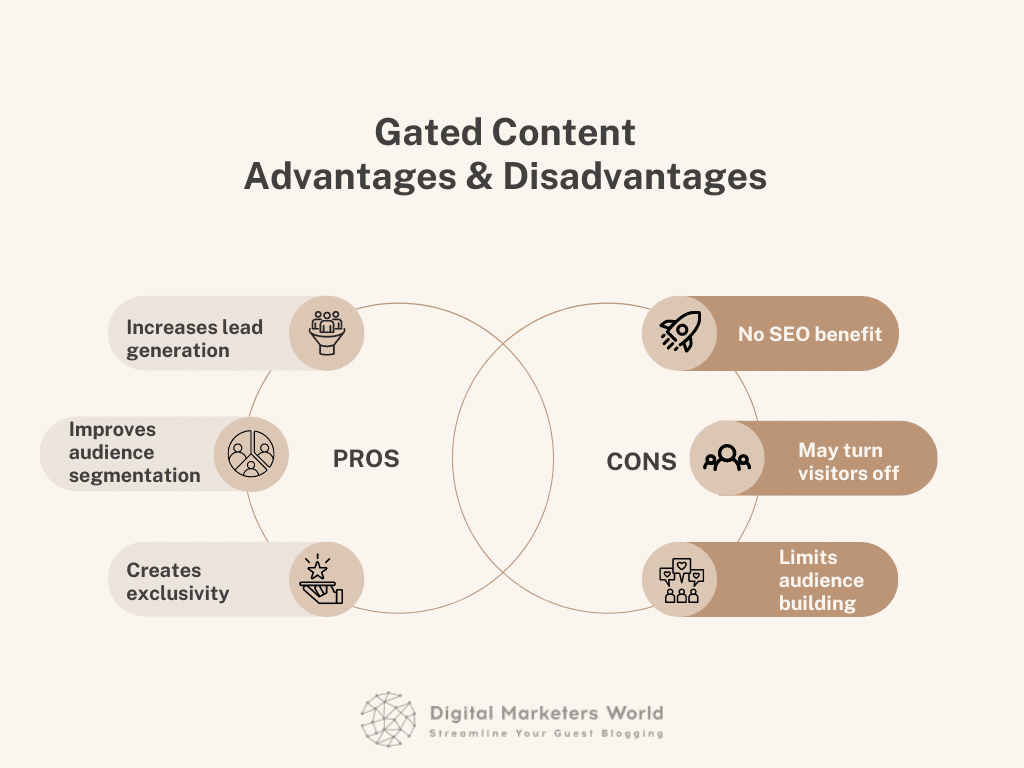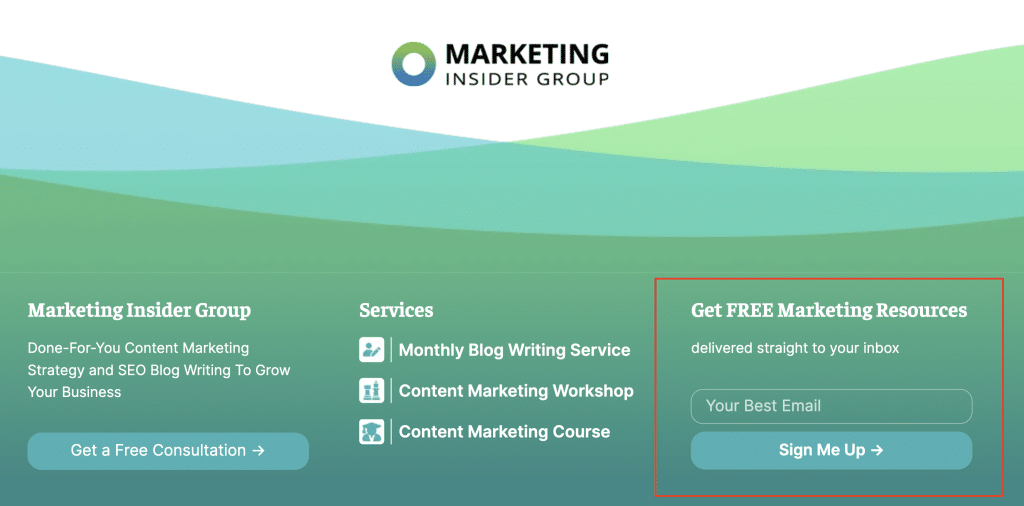
Gated content is a heavyweight in the content marketing ring, perfect for nailing conversions and pulling in leads. But let’s be real, putting together this kind of content is no walk in the park. It stings to see your hard work just sitting there, with hardly anyone taking notice.
John Perelman hit the nail on the head when he said, “If content is king, distribution is queen and she wears the pants.” That’s spot-on for gated content.
So, if you’re about to roll out gated content and want more than just a pat on the back from your team and family, here’s a no-nonsense 6-step checklist to make sure it actually gets seen by your audience.
Quick Takeaways
- Gated content effectively generates leads by exchanging valuable resources for user contact information.
- The strategy faces challenges like accessibility barriers, SEO limitations, and the need for continuous content updates.
- Successful content requires alignment with audience needs, the buyer’s journey, strategic promotion, and data-driven adjustments.
- The success of gated content is measured by conversion rates, lead quality, post-download engagement, audience feedback, and ROI.
Understanding the Pros and Cons of Gated Content
Gated content refers to online materials that require users to fill out a form or provide contact information to access. This type of content is typically used by businesses to generate leads by offering valuable resources in exchange for user details. Think of gated content as:
- Whitepapers
- Ebooks
- Reports
- Webinars
- Exclusive articles
The main goal is to create a mutually beneficial exchange: users receive valuable information or resources, and businesses gain potential leads and insights into their audience’s interests and needs. But, just like any marketing tactic, gated content has its pros and cons:

Image Source: Digital Marketers World
Pros
- Lead Generation Machine: We use gated content because it’s a powerhouse for generating leads. You want someone’s contact info? Offer them something valuable behind a form. It’s that simple.
- Qualifying Leads: People who take the time to fill out a form are usually more interested in what we have to say. This means we’re not just getting leads; we’re getting quality leads.
- Content Value Perception: Putting content behind a gate sends a message that it’s worth the extra step. It’s like saying, “This isn’t your everyday blog post; it’s something special.”
Cons
- Barrier to Entry: Not everyone wants to fill out a form. This means we might lose out on reaching a wider audience because some folks just bounce at the sight of a form.
- SEO Sacrifices: Search engines can’t see gated content, which means it’s not directly helping our SEO game. We have to get creative with landing pages and snippets to work around this.
- Quality Expectations: Gated content isn’t a set-it-and-forget-it deal. We need to keep it fresh, relevant, and worth the effort for our audience, which means regular updates and promotions.
To be successful with gated content, you need to strike the right balance and know your audience. Use it wisely, and it can be a powerful tool in your content marketing arsenal.
6 Steps to Launch and Promote Gated Content
1. SEO-Optimized Landing Page
SEO is an incredibly important aspect of content marketing since most buyer journeys begin with a simple Google search.
Therefore, if you’re creating a gated piece of content that is intended to answer your customers’ questions (and hopefully you are), an SEO-optimized landing page is an important platform your asset needs to be found by early-stage buyers.

2. Email Announcement
The most impactful way you generate downloads for your gated piece of content is to send an email announcement to your customer and prospect newsletter subscribers.
This is an audience who has opted-in to receiving and presumably likes your content. This audience is your lowest hanging fruit and your best chance for high download conversion rates.
3. Download Email Confirmation
The experience someone has with your brand shouldn’t stop once they hit the download button. Automating a powerful download confirmation email is another opportunity for you to recommend additional content or to sign up for a demo on your site.
Leverage this interaction wisely and don’t throw away an opportunity to continue the conversation with your customers and prospects.
4. Website CTAs
Hopefully your site receives some amount of traffic from other ongoing marketing initiatives, such as social media, SEM, organic search or even direct visitors. Don’t forget to let these visitors know you have a new asset to offer. Make sure you update any calls-to-action on your site to promote your new gated content.
Video Source: Lemonlight
5. Paid + Organic Social
Social media can be an incredibly effective way to spread the word about your new content. Depending on your industry, some channels may be more effective than others.
If you’re still testing out your social channel distribution, be sure to allocate the same budget and same goals for each campaign. That way you won’t end up comparing apples to oranges. It’s also important to install each channel’s snippet to your site, so you’re able to effectively measure conversions.
6. Zemanta
Unfortunately, even the most SEO-optimized landing page requires some time to earn its Google juice and find its way to the top of organic search results. Zemanta is a great way to kickstart your branded and unbranded search traffic and help give your landing page an extra boost.
Aligning Gated Content with Your Content Strategy
When we talk about slotting gated content into your content strategy, we’re not just throwing darts in the dark hoping something sticks. It’s about being smart and strategic—like a chess master planning several moves ahead.
According to a recent study, 80% of marketers report their lead generation efforts are only slightly or somewhat effective. That’s a lot of room for improvement.

Image Source: Gitnux
So, how do we make gated content work harder for us? Alignment. Your gated content needs to fit snugly within your broader content strategy, serving as a key player in your quest to engage, convert, and retain.
1. Know Your Audience
Start by understanding who you’re talking to. What do they need? What problems are they trying to solve? Your gated content should be the answer they’ve been searching for.
2. Map It to the Buyer’s Journey
Every piece of gated content should clearly align with a specific stage of your audience’s journey. Early stages? Think educational, thought leadership pieces. Nearing a decision? Product guides or case studies can help nudge them in the right direction.
3. Promote Wisely
Don’t just lock up your content and throw away the key. Promote your gated pieces through your ungated content. Blog posts, social media, and email newsletters are your allies here, guiding your audience to that gated content at just the right moment.
4. Measure and Tweak
Use the data. Are people signing up? Are they engaging with the content post-download? This feedback loop is crucial for refining your approach and ensuring your gated content is doing its job effectively.
Measuring the Success of Your Gated Content
You’ve put in the work to create and promote your gated content. Now, how do you know if it’s actually doing its job? It’s not just about feeling good because your download numbers are up. We need cold, hard data to show us the way.
So, how do we tackle this? By setting clear, measurable goals and tracking the right metrics. Here’s what you need to keep an eye on:
- Conversion Rates: This is the bread and butter of gated content success. How many visitors are turning into leads? If they’re downloading your content, you’re on the right track.
- Lead Quality: Not all leads are created equal. Are your content leads moving through the sales funnel? High-quality leads engage with your sales team, request demos, or sign up for trials.
- Engagement Post-Download: It’s not just about the download; it’s what happens after. Are your leads opening your emails, clicking through to your site, and engaging with more content? This shows the real value of your content.
- Feedback: Sometimes, you’ve got to go straight to the source. Surveys or follow-up emails can provide invaluable insights into how your audience perceives your gated content.
- ROI: Ultimately, it’s about the return on investment. Are you seeing a tangible benefit from your content in terms of revenue, customer acquisition, or other key business metrics?
Remember, the ultimate goal is to foster relationships that drive your business forward. By keeping a close eye on these metrics, you can fine-tune your strategy, making sure your gated content is not just a lead generation tool, but a cornerstone of your marketing success.
Maximize Your Impact with Gated Content Today
Gated content is a big deal in content marketing for generating leads and building relationships. Yes, it has its challenges, but with the right strategy, keen audience alignment, and sharp focus on the metrics that matter, you can engage your audience and drive your marketing forward.
Ready to maximize your gated content’s impact? Check out our SEO Blog Writing Service or schedule a quick consultation to learn more about how Marketing Insider Group can help you earn more leads for your business.
0 Commentaires